
16 minute read
GENERATIvE RETRIEvAL IN ENGLISh
I follow a similar procedure for the production and testing of hydrogen: explain, show, use MWB supports, check for understanding.
Following this, students are ready for independent practice, and among more straightforward ones, I will ask questions like:
Advertisement
• What are the differences and similarities between testing for carbon dioxide and testing for hydrogen?
• A student says to test for carbon dioxide, you add calcium carbonate to limewater. Explain why the student is wrong.
• A student wants to test for carbon dioxide and mixes calcium oxide with hydrochloric acid. Explain why this would not work.
• In the limewater test we did, where is the calcium chloride at the end of the reaction?
• Where is the water at the end of the reaction?
• Where is the carbon dioxide at the end of the reaction?
• A student is asked: Describe how you can test for hydrogen And answers: Use the squeaky pop test Explain why the student’s answer is not good enough.
• Complete the table below:
Gas test Result Conclusion
Bubble through limewater Squeaky pop
Limewater does not change Carbon dioxide is not present
Hydrogen is not present
These aren’t necessarily “exam questions,” but they do promote deeper thought about the tests.
In sum, we are now much closer to our stated aim of having students not only able to recall the gas tests accurately, but to better understand the process that enable them, the similarities and differences between them, and the correct language to employ when describing them.
How I would TeacH… FracTIons
Here, Shannen Doherty explains her teaching methods and thought processes as she teaches students the topic of Fractions in Maths.
By Shannen Doherty
I love nothing more than planning and teaching fractions, so I am going to be taking you through my thought process and all the internal debates I have when planning to teach the objective ‘add and subtract fractions with the same denominator’. On the surface this objective may seem quite simple, but there is an underlying depth that must be exposed for our pupils to have a real understanding of operating with fractions. First and foremost, this must be part of a wider process in which you have already mapped out how your fractions unit will be sequenced. You need to know when you’re teaching it and why it slots into your curriculum at that moment. This isn’t a one lesson job. I’d plan a sequence of lessons where I make subtle tweaks as we go along to ensure the children have a rich experience and deep understanding.
Some of the internal debates I have when planning:
• Do I introduce the concept with a problem and pull out the maths or start with the maths and apply it to a problem?
• Do I teach the rule first or do I generate this with the children?
• Do I show the children the obvious misconception of adding the numerators and denominators or do I wait for this to happen and then draw their attention to it?
• Do I start with bar models or circles?
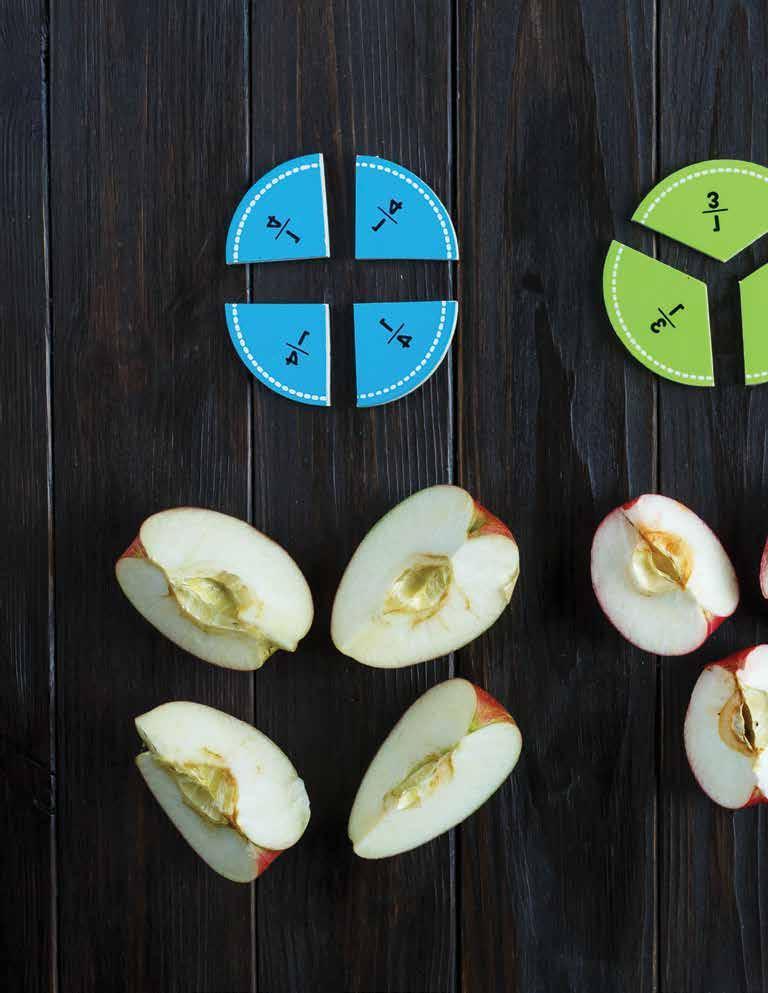
• Do I show two fractions being added on one bar/circle or two bars/circles?
• Do I use one colour throughout or one colour per fraction?
• Do I start with bars/circles pre-filled in or do I expect the children to make the representation and do the calculation?
• When do I add in a third addend?
• Do I teach adding and subtracting simultaneously or one after the other?

Starting with a problem here means that what was quite an abstract idea is now rooted in a relatable context. so wHere To sTarT?
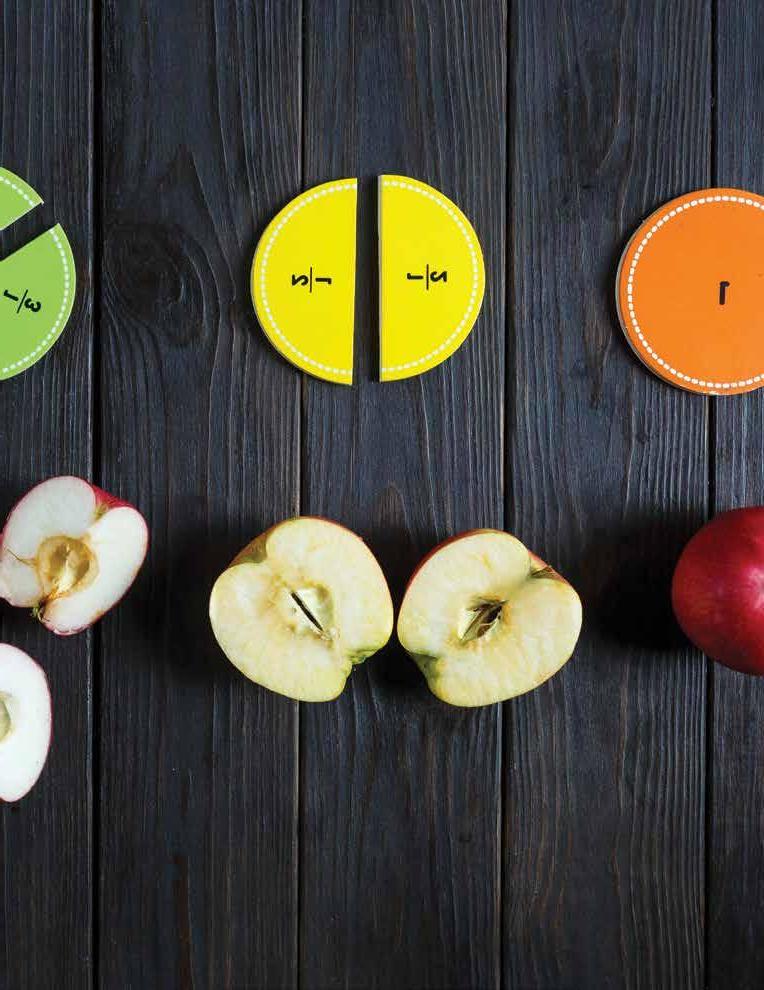
Where you stand on this may differ from concept to concept, but it’s crucial that you consider what you’re doing and why. When I teach adding and subtracting fractions with the same denominator, I prefer to kick off with a problem such as ‘Tommy eats two quarters of a chocolate bar and Seema eats one quarter. What fraction of the chocolate bar has been eaten?’ Starting with a problem here means that what was quite an abstract idea is now rooted in a relatable context.
I am in favour of getting the misconceptions out there early on. I will often say to my class ‘This is what some of you might want to do and why it isn’t right.’ and then show them the misconception in action, and we’ll pick apart the maths to reveal why it doesn’t work. In this case, I will show them something like 2/4+1/4=3/8. Then I will draw this out (and they’ll be very familiar with drawing out fractions from all the work leading up to this point) and the penny will drop when they see that 3/8 is smaller than the two fractions we were adding. Getting this out in the open first thing will reduce the number of children who make this mistake and secure their understanding further. Why wait for a mini plenary when you can nip it in the bud early on?
The easy thing to do next would be to tell the children ‘When we add fractions with the same denominator, the denominator remains the same.’ and give them a stream of calculations where they will perform that very thing. I have no issue with teaching rules, but they must be accompanied by representations that expose the deeper structures. Rather than teach this as a rule, I would generate this will the class and use it as a stem sentence. The children can repeat the sentence again and again so it becomes ingrained in their verbal explanations but doesn’t become a meaningless crutch.
I have the stem sentence displayed on my maths wall and slides as we go along and will gradually remove it. The stem sentence needs a visual representation to go with it, so I would use the same problem that we started with and show the children that when we have two quarters and we add another quarter, it becomes three quarters because the unit I am working with is a quarter.
There are so many representations to choose from, some better than others and some easier to use than others. Ultimately, you want to give your pupils the best journey through these models to develop their understanding as they go. Fractions are often represented with circles (usually cake and pizza!) but this isn’t a user-friendly image. You must consider what has come before, which is why sequencing and knowing a unit of work’s journey is vital. Children in my class will be used to bar models from earlier work so it makes sense to start with bars. Then you might want to move onto circles later so they’ve been exposed to it, but you can’t expect children in Year 3 and 4 to accurately split a circle into equal parts so you’ll want to provide the circle already split! Another useful model to use is a number line. Again, this is only helpful if the class have a good understanding of number lines. Showing how a number line is split into intervals of 1/5 and how you can add fifths on the number line would strengthen your pupils’ understanding of both fractions and number lines.
When showing fractions being added on bars, I use one bar for each whole and different colours. Colour can be an incredibly powerful tool in the classroom. Showing the children a bar with 2/6 in blue and 3/6 in green means you can ask the class ‘What fractions have been added together here?’ and they will be able to see it instantly. I think colouring or drawing onto the same bar makes sense so the children get used to working with the whole, and adding another whole bar if the sum is greater than one. This is where I would tend to show a third addend and highlight that the process is the same regardless of how many fractions you are adding.
You want to keep the process as simple as possible. When I design tasks and questions, I think about what I want the children to learn. To start off, I would give them a bar already coloured in and simply ask them to identify the calculation that has been done. Then, I might move onto the reverse by giving them the calculation and asking them to colour in the bar.
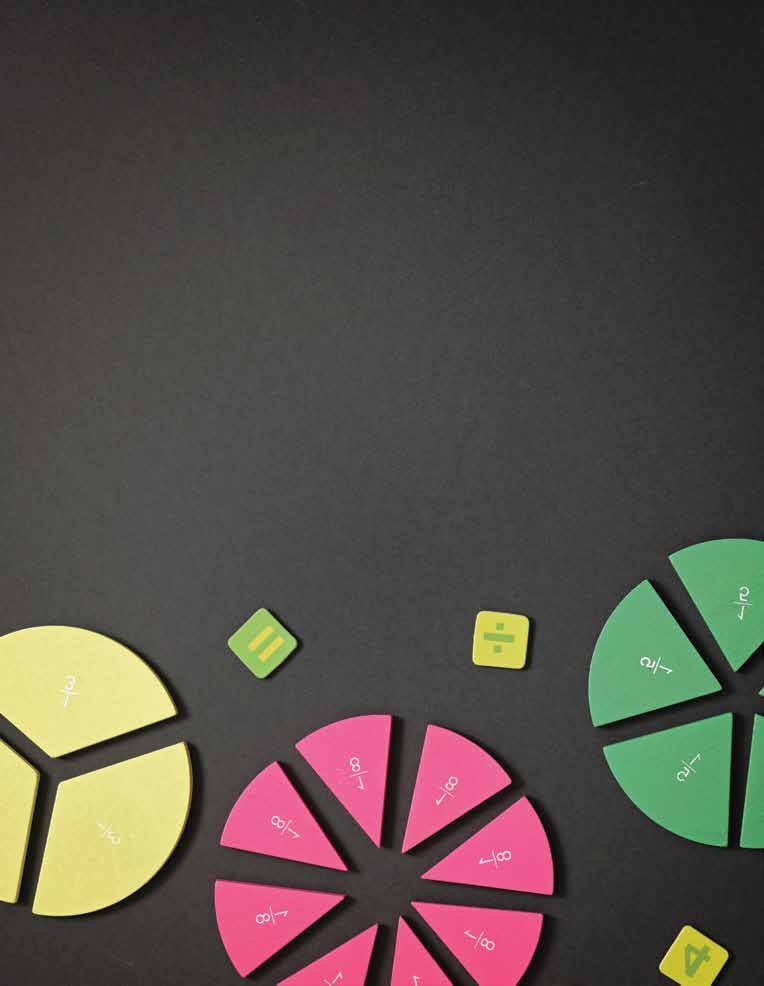
Something I picked up when working with a teacher from Shanghai was the idea of showing the addition of the numerators above the denominator to reiterate that it’s only the numerators being added. Then to push the children’s thinking on and remind them of prior work, I would use part-whole models and missing number questions, rather than lots of the same style of question.
And then once all of this has been done… we move onto subtracting like fractions! This should be simpler because you’ve already laid the groundwork with addition. Stick to the same types of representations but show the process of shading the minuend and crossing out the subtrahend.
The main message here is regardless of how many complex internal debates we have when planning, we must keep it simple for the children.



54. The Rise And Rise Of Teacher Radio Of Teacher Radio
Why are teacher radio stations becoming so popular?
56. Lessons Learnt Teaching Science In Prison
What teaching in prisons can tell us about how we teach some students in teach some students in school


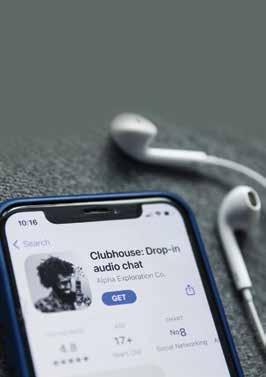
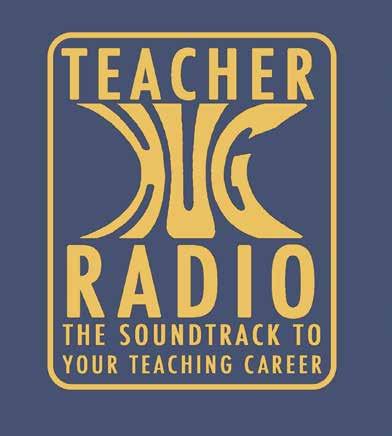
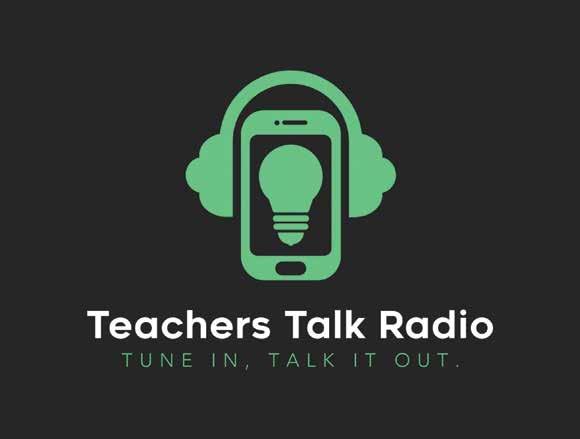
THE RISE AND RISE OF TEACHER RADIO
Teacher radio has burst onto the edu-scene and it looks like it’s here to stay. But why is it so popular? Andy McHugh gives his thoughts...
It’s early on Saturday morning and I’m making breakfast in the kitchen. I used to stick some music on, or listen to a comedy podcast, while the kids watch their cartoons in the living room. Radio isn’t really my thing - too many adverts and presenters trying to be cool. Now though, I fi nd myself tuning into teacher radio shows. At this point, I know that I’ve lost some of you.
Teachers? Presenting a radio show? About teaching? ON A SATURDAY MORNING???
I do wonder what prompted the recent emergence of teacher radio. Was there simply a niche that wasn’t being fi lled, or were teachers crying out for more ways to listen to and interact with their favourite “edu-celebrities” (for want of a better word). Either way, I don’t think it matters.
It seems I’m not alone. Since its inception in January 2021, Teacher Talk Radio has made its way into the daily lives of thousands of teachers. In fact, at this point in time, Teacher Talk Radio alone has had over 20,000 live listeners and upwards of 150,000 downloads. I sense this is only just the beginning.
The radio format is a tried and tested one. Edu-podcasts are incredibly

By Andy McHugh
popular, but they lack the one thing that radio is able to provide: live interaction. Guests can call in or tweet to share their experiences, ask and answer questions, or just to air their opinions. The radiostyle feels less formal and it’s much easier on the ear, more like overhearing a conversation rather than listening to a polished speech. It’s hard to maintain focus on anything complex fi rst thing on a Saturday morning while I’m making pancakes. I’m a huge fan of podcasts and I absolutely love watching videos on YouTube, but teacher-radio really has added something else, something new. To misquote a famous song: radio killed the video star.
Teachers have consumed edu-media for a long time, via blogs and more recently, podcasts. In the last year though, the live-audio format has enjoyed huge success. Clubhouse, the self-styled “Social Audio App”, has allowed people to get together virtually for an interactive audio experience. While I do enjoy peeking into the di erent “rooms” to hear what is going on, it can feel a little like an exclusive club. They all seem to know each other and I’m just the outsider looking in. Teacher radio feels just the opposite. When I tune in, I feel like I’m in the sta room, listening to a friend, a mentor, or just that entertaining teacher who captivates everyone’s attention with their funny anecdotes and fl air for storytelling.
Most of the presenters themselves are practising classroom teachers and this lends a level of authority that other media often lacks. It’s good to know that when you’re being o ered advice, or when someone is telling you what “it” is really like, that they are, in fact, just like you. And not only that, they’re in the trenches with you. They too have lessons to plan for tomorrow and their kids’ school uniform to iron. They’re also trying to fi gure out how to fi t in marking mock papers, applying for that promotion and how on earth they’re going to get to their child’s footy practice by 5pm. They. Are. You.
Listening to teacher radio might not be something you’re interested in, but give it a go anyway. I bet you’ll feel part of it. You might even end up getting involved. Either way, I’ll still be listening.
LESSONS LEARNT FROM TEACHING SCIENCE IN PRISON

What can we learn from successful teaching in prison, where the students are often those who didn’t engage well in school? The pioneers of the Think Like A Scientist programme give their verdict on what made the di erence when they taught in prison.

By Phil Heron & Jamie Williams


Think Like A Scientist is a course designed to improve critical thinking and encourage independent thought for people in prison. The programme, the fi rst of its kind in England, uses short, impactful talks on science topics to bring new information to the class. Through dialogic teaching methods and guided by a critical thinking framework, the students are taught to analyse and openly discuss research and to connect with the outside world through learning about space missions, climate change, natural hazards, the Universe, the science of sleep, and artifi cial intelligence.
Many of those who participated in the programme have, historically, not engaged well with formal education. Based on our course feedback, we outline below some practical advice for teaching such students and specifi cally for students who have no confi dence in either themselves and/ or in the education system.
To address this issue in our own programme, we aimed to create a classroom dynamic that is accessible, inclusive, and relatable to students from all backgrounds.


Engaging Hard To Reach Students
Education and employment have been highlighted by the Ministry of Justice as key points in reducing re-o ending rates. However, due to restrictive prison environments (Rogers et al., 2014), a lack of funding for prison educational programs, and (most importantly) the impact of prisoners’ previous struggles with traditional classroom settings, teaching in prison is a complex endeavour. As such, educational needs are largely unmet for those in custody (Geib et al., 2011).
To overcome these obstacles, a key component of Think Like A Scientist is to align education to the needs of students that are harder to reach, rather than students adapting to the pace and structure of an infl exible education program.
As a result, the course acts as a stepping-stone to more formal education (e.g., GCSEs, A-Levels, and undergraduate courses) through increasing confi dence in the student’s abilities in the short and long-term.
Keep It Relatable
Critical Educational Neuropsychological research (Billington, 2017; Damasio, 2000) has indicated how social, emotional, and cultural factors impacting disadvantaged students cannot be separated from a student’s cognitive ability to learn within formal environments. Furthermore, research into ‘Stereotype Threat’ (Steele and Aronson, 1995; Pennington et al, 2016) suggests that students who believe themselves not to ‘fi t’ into educational settings are more likely to perform poorly or withdraw, due to the impression they do not match the profi le of students who usually succeed. This can be due to feelings of stigma or ‘minority stress’ (Meyer, 1995; Parker, 1999), relating to race, religion, disability, economic status, sexuality, gender or other intersecting cultural factors; stigma often felt to be subtly reinforced in the language and hierarchies used in classroom settings.
A challenge here was to use relatable cultural references and ‘Plain Speak’ English when teaching, as well as considering who and what




was rewarded and prioritised in interactions with students (Goodley et al, 2017).
By visiting successful prison education programs during the development of Think Like A Scientist, it was clear that learners engaged best when the material was relatable (e.g., classes related to criminology and law). Although some topics of our class are directly applicable to daily life (e.g., sleep), the majority of the course focuses on how we think about a subject - a process which is inherently relatable. Think Like A Scientist teaches the ‘the scientifi c method’ - a framework where we explore what we do not know about a subject and discuss how we can fi nd out more.
For instance, each session starts with us asking the group to list anything related to the main topic (e.g., what do we know about the solar system?). From here we can understand the key areas to focus on and ask how we can fi nd that out (e.g., Do we need to visit Mars to check for life? Can we send robots? What would they look like? How would they work?).
By shifting the focus of the program to be about how we think about a subject rather than what we know, the material becomes applicable to everyone. Crucially, this creates an open structure, rewarding exploration and engagement over attainment, suggested to be positive for all learners’ self-esteem and progression (Usten & Eryilmaz, 2018; Saloviita, 2020; Hornby, 2020)








